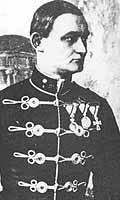Rudolf Szepessy-Sokoll | |
|---|---|
 Rudolf Szepessy-Sokoll in Hussar uniform | |
| Born | c. 1891 Hungary |
| Died | 6 November 1917 (aged 25–26) Vicinity of Latisana, Italy |
| Allegiance | Austro-Hungarian Empire |
| Service | Hussars; Austro-Hungarian Aviation Troops |
| Years of service | 1914–1917 |
| Rank | Oberleutnant |
| Unit | Fliegerkompanie 17; Fliegerkompanie 10; Fliegerkompanie 27; Fliegerkompanie 3; Fliegerkompanie 41J; |
| Awards | Order of Leopold, or Order of the Iron Crown; Military Merit Medal; Medal for Bravery |
Oberleutnant Rudolf Szepessy-Sokoll Freiherr von Negyes et Reno (commonly called Rudolf Szepessy-Sokoll) (c. 1891– 6 November 1917) was a Hungarian World War I flying ace credited with five aerial victories. He began his military career as a cavalryman as the war began in 1914. After winning the Silver Medal for Bravery and being promoted into the officers' ranks, he transferred to the Austro-Hungarian Aviation Troops in mid-1915 as an aerial observer. On 14 February 1916, while participating in a historic strategic bombing raid on Milan, he scored his first aerial victory. After shooting down another airplane and an observation balloon, Szepessy-Sokoll was transferred to a fighter unit after pilot training. After shooting down a pair of Macchi L.3s on 5 November 1917, he was killed in action the next day.
He flew a strategic bombing mission directed against Milan, Italy, on 14 February 1916; this is believed to be the first strategic bombing mission in history.[1][better source needed]
- ^ The Aerodrome website Accessed 29 October 2021.